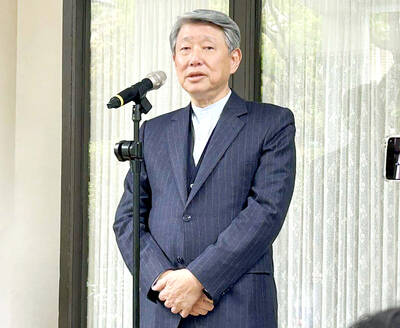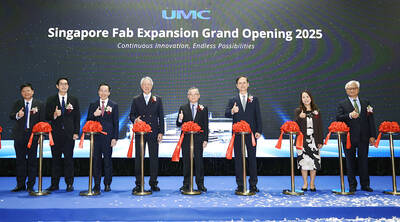Taiwan Semiconductor Manufacturing Co (TSMC, 台積電), the world’s largest contract chipmaker, raised its first-quarter outlook yesterday on the back of growing rush orders based on rising demand from China and the strengthening US dollar.
“TSMC’s first-quarter business is expected to be better than the company’s previous guidance given on January 22, 2009,” TSMC chief financial executive Lora Ho (何麗梅) said in a statement. “This is primarily due to rush orders, especially from the mainland Chinese market, and a stronger US dollar.”
TSMC expects first-quarter revenue to be between NT$36 billion and NT$38 billion (US$1.04 billion and US$1.1 billion), up from the NT$32 billion to NT$35 billion TSMC estimated in January.
The new estimate, however, is a 40 percent decline from last quarter’s NT$64.56 billion.
Operating profit margin may range from flat to negative 2 percent, which is also better than the company’s previous estimate of between minus 19 percent and minus 15 percent, TSMC said.
Gross margin may range between 14 percent and 16 percent in the current quarter, rather than between 1 percent and 5 percent as previously estimated, the statement said.
The revision, the latest in a slew of outlook upgrades by chip companies including Macronix International Co (旺宏電子) and MediaTek Inc (聯發科), might help TSMC avoid posting its first quarterly loss since the 1990s for the current quarter, which ends March 31.
TSMC chief executive Rick Tsai (蔡力行) told investors in January the Hsinchu-based chipmaker might swing into losses this quarter, saying the bleak economy had hurt demand for all kinds of electronics.
“A stronger US dollar should be the main factor bringing TSMC’s bottom line back to the break-even point from the brink of falling into losses. Falling non-operating losses will also help,” a semiconductor analyst with KGI Securities Co Ltd (凱基證券) said on condition of anonymity.
“February should be the worst period for TSMC,” the analyst said, adding that the effect of rush orders would magnify in the second quarter mainly from growing orders from handset chipmakers Broadcom Corp and Qualcomm Inc.
TSMC sales reached NT$12.18 billion last month, down 58.4 percent from NT$29.28 billion a year ago, or down 7.3 percent month-on-month, the company said. In the first two months, revenues totaled NT$25.3 billion.
TSMC shares dropped 2.28 percent to NT$47.15 yesterday, underperforming the TAIEX, which gained 0.92 percent.
The company provided its revised guidance after the stock market closed.
United Microelectronics Corp (聯電) shares rose 1.44 percent to NT$9.15 yesterday. The company reported a 57 percent year-on-year decline on Monday, or 0.29 percent month-on-month decline, in sales last month at NT$3.14 billion.

MULTIFACETED: A task force has analyzed possible scenarios and created responses to assist domestic industries in dealing with US tariffs, the economics minister said The Executive Yuan is tomorrow to announce countermeasures to US President Donald Trump’s planned reciprocal tariffs, although the details of the plan would not be made public until Monday next week, Minister of Economic Affairs J.W. Kuo (郭智輝) said yesterday. The Cabinet established an economic and trade task force in November last year to deal with US trade and tariff related issues, Kuo told reporters outside the legislature in Taipei. The task force has been analyzing and evaluating all kinds of scenarios to identify suitable responses and determine how best to assist domestic industries in managing the effects of Trump’s tariffs, he

TIGHT-LIPPED: UMC said it had no merger plans at the moment, after Nikkei Asia reported that the firm and GlobalFoundries were considering restarting merger talks United Microelectronics Corp (UMC, 聯電), the world’s No. 4 contract chipmaker, yesterday launched a new US$5 billion 12-inch chip factory in Singapore as part of its latest effort to diversify its manufacturing footprint amid growing geopolitical risks. The new factory, adjacent to UMC’s existing Singapore fab in the Pasir Res Wafer Fab Park, is scheduled to enter volume production next year, utilizing mature 22-nanometer and 28-nanometer process technologies, UMC said in a statement. The company plans to invest US$5 billion during the first phase of the new fab, which would have an installed capacity of 30,000 12-inch wafers per month, it said. The

Taiwan’s official purchasing managers’ index (PMI) last month rose 0.2 percentage points to 54.2, in a second consecutive month of expansion, thanks to front-loading demand intended to avoid potential US tariff hikes, the Chung-Hua Institution for Economic Research (CIER, 中華經濟研究院) said yesterday. While short-term demand appeared robust, uncertainties rose due to US President Donald Trump’s unpredictable trade policy, CIER president Lien Hsien-ming (連賢明) told a news conference in Taipei. Taiwan’s economy this year would be characterized by high-level fluctuations and the volatility would be wilder than most expect, Lien said Demand for electronics, particularly semiconductors, continues to benefit from US technology giants’ effort

‘SWASTICAR’: Tesla CEO Elon Musk’s close association with Donald Trump has prompted opponents to brand him a ‘Nazi’ and resulted in a dramatic drop in sales Demonstrators descended on Tesla Inc dealerships across the US, and in Europe and Canada on Saturday to protest company chief Elon Musk, who has amassed extraordinary power as a top adviser to US President Donald Trump. Waving signs with messages such as “Musk is stealing our money” and “Reclaim our country,” the protests largely took place peacefully following fiery episodes of vandalism on Tesla vehicles, dealerships and other facilities in recent weeks that US officials have denounced as terrorism. Hundreds rallied on Saturday outside the Tesla dealership in Manhattan. Some blasted Musk, the world’s richest man, while others demanded the shuttering of his